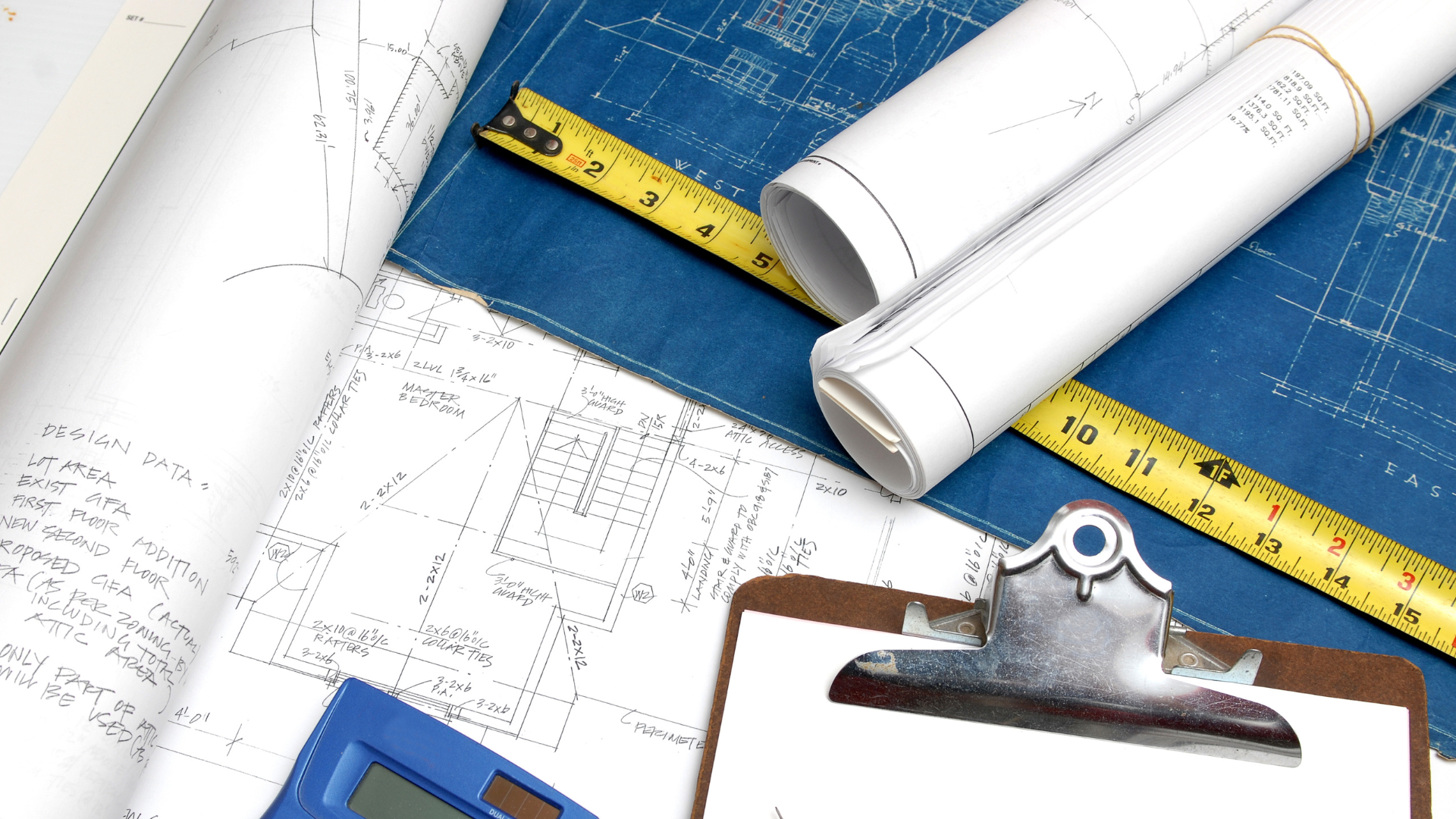Audio Overview: Listen & Learn
The construction industry is evolving faster than you think.
You’re handling job sites, managing budgets, coordinating crews, and every minute counts. Learning a new system probably feels like one more thing on an already full plate.
But whether you're handling small builds or big jobs, there’s a faster, cleaner way to run your day-to-day.
This guide is for the skeptical contractor. We’ll break down how construction technology helps you save time, stay organized, reduce costly errors, and take on more jobs without adding stress to your day.
A Contractor’s Guide to Embracing Construction Technology
Today’s construction technology isn’t just for the big players but rather for every company, whether small or mid-sized.
As the construction industry continues to push toward smarter, faster, and more tech-driven workflows, tools such as project management software and mobile field apps are now designed to address real-world challenges, including tight timelines, lean crews, and hands-on managers.
Key Takeaways
- Without technology, construction businesses face delays, miscommunication, and manual tasks, which drain time and profit, lack real-time job visibility, and miss growth opportunities.
- Construction technology provides centralized project management, rapid estimates, real-time communication, better safety and compliance, and improved decision-making via detailed reports.
- Select the ideal construction tech tool by evaluating platform-specific features, posing key questions, and prioritizing essential features for your workflow.
- You don’t need a huge team or budget to start seeing benefits.
- Modern software like Constructionbase helps small to mid-sized teams by providing a central hub for managing schedules, site updates, documents, and automating tasks.
Why Contractors Avoid Construction Technology
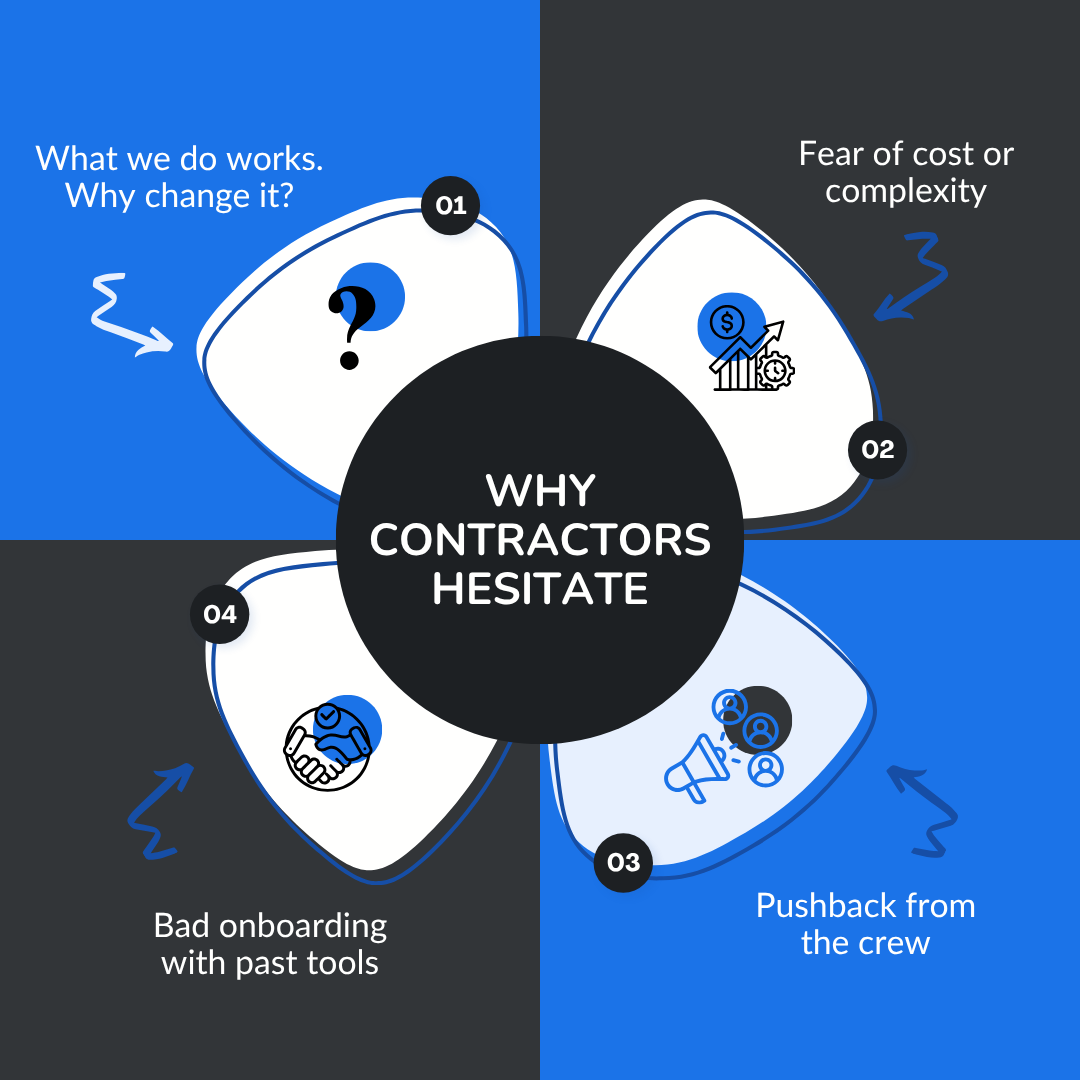
Many contractors hesitate to adopt new tools, and for good reason. When time is tight and the crew’s already busy, change feels like a risk. Here’s what usually holds teams back (and why it doesn’t have to).
1. "Why Change What’s Been Working for Years?" Mentality
If your crew’s been using paper logs, spreadsheets, and phone calls for years, it makes sense to stick with what’s familiar.
But in the construction industry, just because a system gets the job done doesn’t mean it’s doing it well. Manual processes slow things down, lead to errors, and make it harder to scale.
And when time and resources are already stretched thin, it’s easy to put off change. But that delay might be holding your business back from tools that could lighten the load.
2. Fear of Cost and Complexity
Another common reason contractors delay adopting construction technology? Cost. Not just the price of the software itself, but the time it might take to learn and implement it.
It’s a valid concern, especially for smaller teams who already wear too many hats. Labor shortages are prompting firms to adopt tools that enable smaller crews to deliver significant results.
There’s also a lingering myth that construction tech is only worth it if you’re managing huge building projects with dozens of people on site.
In reality, many affordable platforms are designed for small to mid-sized construction firms. And the right tool often pays for itself in saved hours and avoided project delays.
3. Team Pushback and Poor Onboarding
Even when leadership is ready to try something new, the team on-site might not be.
If they’ve struggled with tools that were hard to use or didn’t fit the way they work, it’s understandable they’d be skeptical. No one wants a system that slows them down.
That’s why it’s crucial to pick software built for construction crews, tools that match how work happens on-site, and ensure everyone receives the training they need to use it with confidence.
What You’re Missing Without Tech
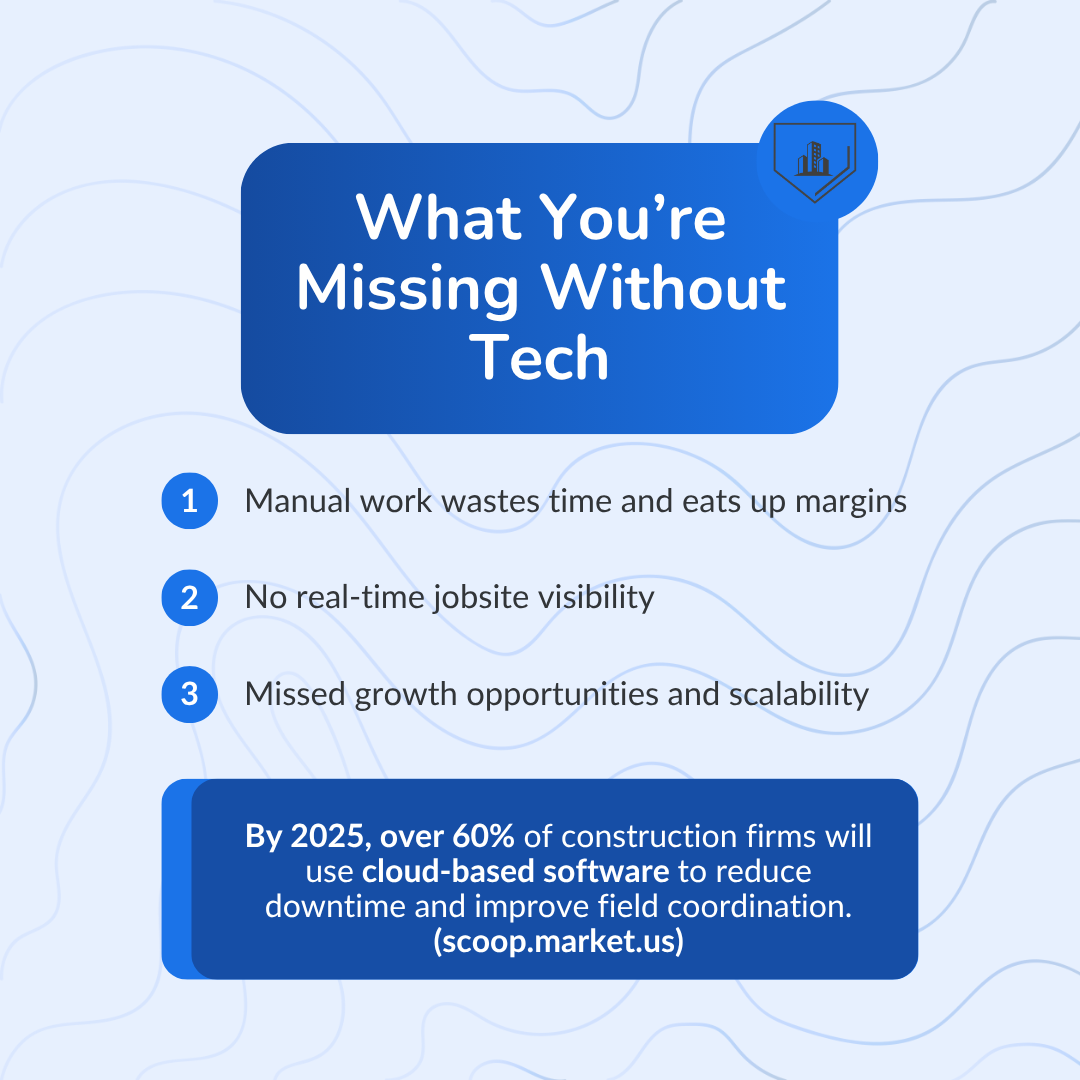
Running a construction business without technology may seem manageable until delays, miscommunication, and manual tasks begin to accumulate.
Here’s what slips through the cracks when you’re still doing everything the old way.
1. Manual Workflows Drain Time and Profit
Let’s say your site manager forgets to text in a material order. Or a field worker writes the wrong job number on a timecard. These small slips might not seem like a big deal, but over time, they lead to costly rework, delays, and confusion.
Construction projects are fast-paced and unpredictable. Manual systems slow you down when what you really need is real-time clarity.
Whether it’s hours spent on data entry or back-and-forth calls for updates, sticking to old workflows chips away at your project timelines and your margins.
2. No Real-Time Job Visibility
By 2025, over 60% of construction companies are expected to manage their projects using cloud-based software, as firms strive to stay competitive, minimize downtime, and enhance real-time jobsite visibility. Those sticking to paper and spreadsheets risk falling behind. (scoop.market.us)
When the field and office teams aren’t working off the same info, it’s easy for things to slip.
Is the crew running behind? Did something change on-site? Was an issue reported?
Without real-time updates, minor problems can quickly escalate into project delays. And if you’re relying on phone calls or end-of-day check-ins, you’re often hearing about it too late.
Construction technology helps keep everyone on the same page, whether they’re out in the field or back at the office.
3. Missed Growth Opportunities
Here’s the truth: you can only grow if your systems can keep up with it.
When everything, from scheduling to billing, depends on a few people manually detailing, it becomes nearly impossible to take on more work without experiencing burnout.
Even worse, without reporting tools, you have no way to spot issues, track what’s working, or replicate success. By skipping tech, many construction firms unknowingly cap their growth potential.
More clients now expect energy-efficient building designs, making it crucial for teams to plan accordingly from the outset.
Also, check out: How Much Money Are You Wasting Without Modern Construction Management Tools?
Construction Technology Benefits: What You Get
Here’s what you get when the right tools are built into your everyday process.
1. Centralized Project Management
Instead of managing spreadsheets, whiteboards, and group chats, everything lives in one place: job schedules, site updates, documents, and team notes. From the office or the field, your team can access what they need and stay on track.
This is where construction project management software shines: fewer questions, fewer missed steps, and smoother handoffs.
2. Faster Estimates and Approvals
Templates, saved line items, and autofill features make quoting much quicker and easier, saving you hours of effort.
And with digital signatures, you’re not waiting days for a go-ahead. It keeps the construction process moving and ensures client satisfaction.
Explore: Estimating and Quoting: Understanding the Difference in Construction Cost Analysis
3. Real-Time Communication Between Teams
When something changes on-site, the right people are notified immediately. Updates are sent instantly, reducing the need for back-and-forth calls, missed messages, and costly mix-ups.
Mobile technologies enable your crews to access plans, log hours, and upload photos without needing to return to the office.
4. Improved Safety and Compliance
Track safety incidents, certifications, and site checklists in just a few taps. Digital safety logs and automated alerts are redefining construction safety standards on modern job sites.
In the construction sector, staying compliant and protecting your team shouldn’t be a guessing game.
5. Better Decision-Making with Reports
Need to check productivity, spot delays, or see how costs are tracking? Reports pull that data together in seconds, so you can act before minor issues turn into expensive problems.
These tools aren’t just about convenience; they support better project planning and ultimately lead to long-term project success.
In fact, companies see a 1.14% revenue boost for every digital tool they integrate, equal to $1.14 million on a $100 million operation. (Deloitte)
What You Can Start Automating Today
You don’t need to overhaul your entire business to see the benefits. Even small bits of automation, such as logging hours or sending invoices, can save you several hours each week.
Here are a few easy wins to start with.
1. Job Scheduling and Time Tracking
Instead of relying on manual logs or last-minute calls, you can assign crews and track their hours through a mobile tool.
GPS-based check-ins make it easy to see who’s on-site, when they arrived, and how long the job is taking. This helps avoid mix-ups and keeps schedules running more smoothly.
2. Document and Photo Capture
Site photos, permits, and inspection notes can all be uploaded and stored by project. You’re not flipping through paper folders or waiting for someone to send a file.
Everything is where it should be, when you need it. It also makes follow-ups and handoffs easier.
3. Materials and Inventory Tracking
Running out of materials mid-job causes delays, and over-ordering wastes money. Efficient tracking of construction materials avoids costly delays and ensures nothing is left to chance.
Automated inventory tracking helps you keep tabs on what’s in stock and what needs restocking, without relying on memory or guesswork.
It’s a practical way to reduce material waste, maximize cost savings, and stay organized.
Smart tracking of building components ensures smoother installation and fewer on-site errors.
4. Invoicing and Billing
Once a job is marked complete, invoice details can be pulled directly from the system. You don’t have to rewrite anything, track down notes, or worry about errors in totals.
When connected to your accounting software, it reduces turnaround time and provides a clearer view of cash flow.
How to Choose the Right Construction Tech Tool
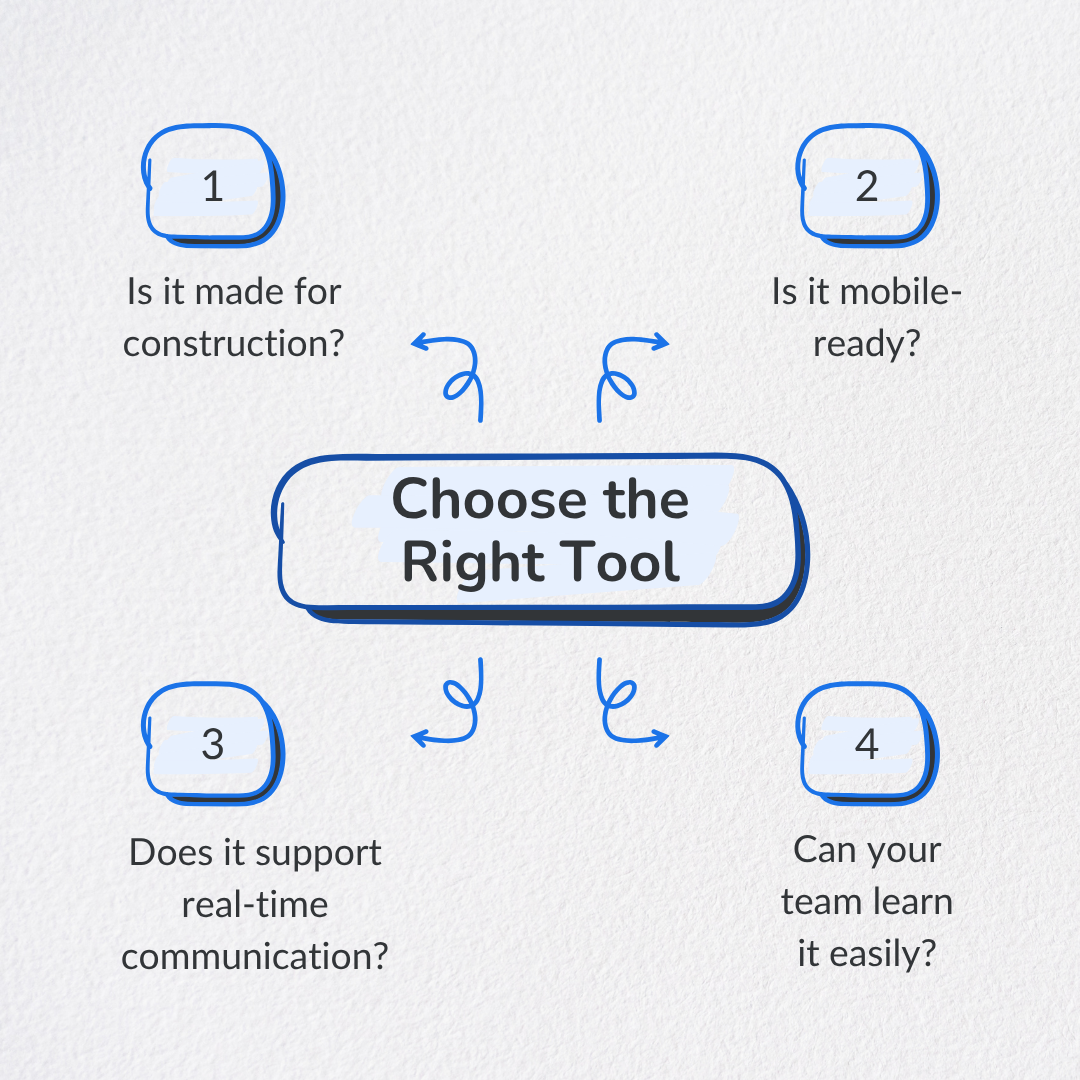
There’s no shortage of construction software available, but not all of it's specifically designed for the job site. Before committing to anything, it’s worth taking a moment to ensure the tool fits your workflow.
Here’s what to look for.
1. Look for Construction-Specific Platforms
Generic tools might work for office teams, but construction sites need something different. Platforms like Constructionbase are specifically designed for the construction industry, with features that support mobile crews, provide real-time updates, and facilitate field-first workflows.
That’s the difference between adapting your process to software vs. using technology in construction that adapts to you.
This is also where integrating construction technology the right way pays off, as it becomes an integral part of how you build rather than a separate task to manage.
2. Must-Have Features to Consider
Every job site encounters new challenges, but certain features should be on your must-have list.
- Mobile access from the field
- Smart scheduling and time tracking
- Photo and document uploads
- Reporting dashboards
- Easy integration with project planning tools
Look for platforms that prioritize usability and speed. Innovative tools don’t need to be complex, they need to work.
3. Ask These 3 Questions Before You Buy
- Will my team actually use it?
- How soon can I expect to see value?
- What support and training is included?
A good tool should support skilled workers, not hinder them. And it should scale with you as your construction projects grow in size and complexity.
Construction managers know that advanced technologies only work if the team using them is confident, equipped, and supported.
Here's your Complete Guide to Selecting the Most Suitable Construction Management Software.
How Constructionbase Helps Contractors Stay Flexible And Adapt to New Challenges
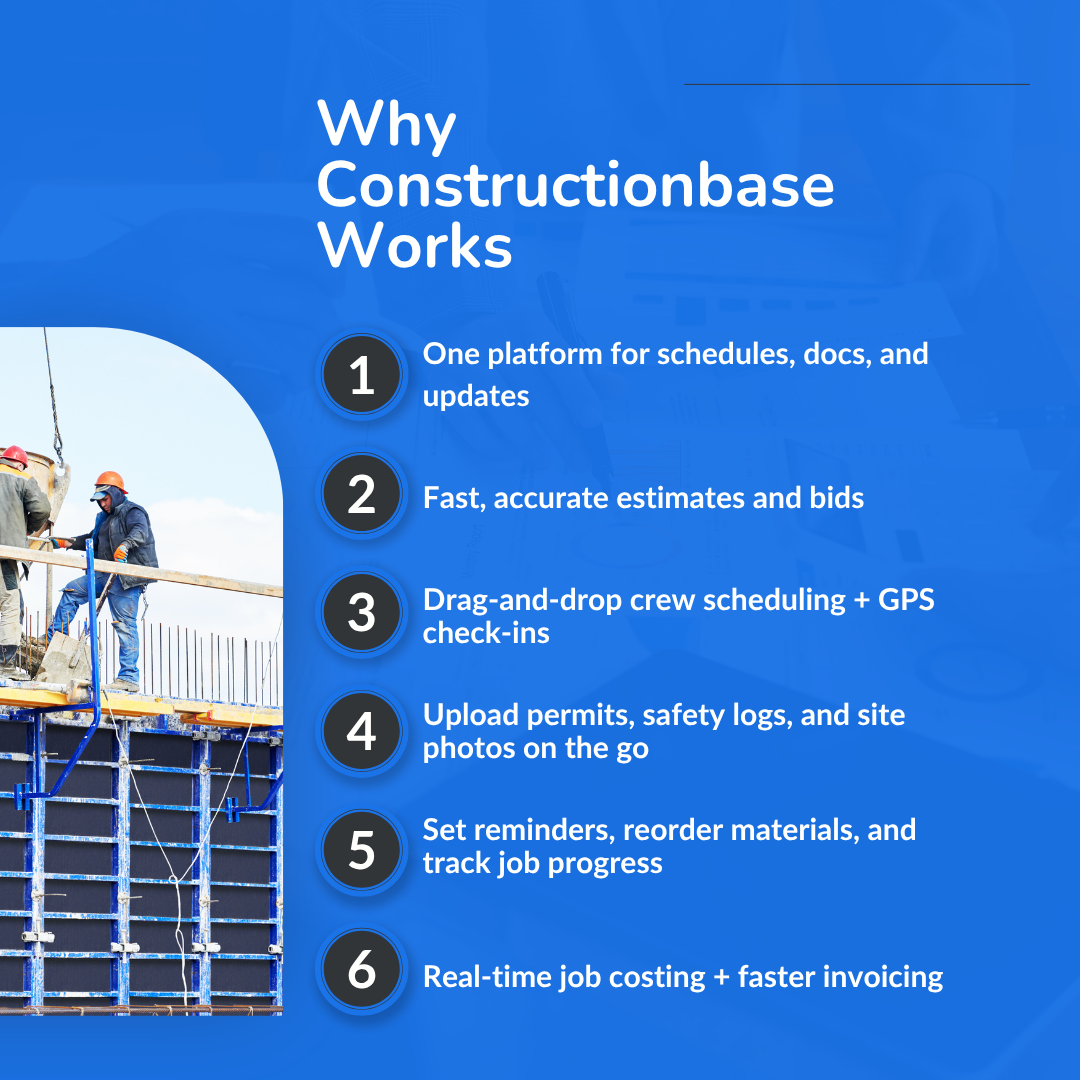
Constructionbase is built for small to mid-sized teams who need more control over their projects without the overwhelm of complex tools.
Here’s what it helps you do:
- Keep everything in one place
From schedules and site updates to documents and team tasks, everything is stored in one platform, so no detail slips through. - Build accurate estimates and bids faster.
Measure blueprints, factor in materials and labor, and send out clear, professional bids without having to start from scratch each time. - Simplify scheduling and crew tracking.
Drag-and-drop scheduling, combined with GPS check-ins, makes it easier to see where teams are, what’s booked, and what needs to be adjusted. - Stay organized on the job site.
Upload permits, safety logs, and site photos directly into each project. Field teams can share updates instantly. No extra apps needed. - Automate what slows you down.
Get reminders, reorder materials, and track job progress without constant check-ins. Constructionbase helps reduce manual follow-ups. - Manage billing and job costs in real-time.
Keep an eye on budgets, approve expenses, and generate invoices that sync with your accounting system, allowing you to get paid faster.
Whether you're managing one crew or many, Constructionbase provides construction professionals with the tools they need to run smoother, smarter projects.
Summary
Technology is here to improve how you build. With the proper setup, construction project management becomes clearer, faster, and less stressful.
From estimating to scheduling, automation is key to enhancing efficiency in every phase of the build.
In an industry where time, labor, and materials are in high demand, adapting to technological advancements such as mobile devices and modular construction methods provides your crew with a competitive edge.
You don’t have to change everything. Just make one part of your process easier, and build from there.
Ready to Make the Shift with Constructionbase?
Curious how this could work for your team?
Book a demo with Constructionbase and see how easy it is to move from scattered paperwork to a streamlined, tech-powered workflow.
Start with one tool. Fix one bottleneck. Then build from there, at your pace, on your terms.
FAQs
1. How does construction technology improve daily operations?
It reduces manual work, keeps your field and office teams aligned, and helps you respond faster to changes. From scheduling to billing, tech streamlines the entire construction process.
2. Is technology worth it for small construction sites?
Yes. Even small crews benefit from tools that reduce errors and improve communication. The right platform helps you track progress, minimize manual labor and delays, and stay on top of costs without adding complexity.
3. What are some examples of innovative tools in construction?
Cloud-based project tracking, mobile time logs, resource allocation, and blueprint-based estimating tools are just a few. Some companies are also exploring virtual reality for site planning and artificial intelligence to predict cost overruns.
4. How does technology help with worker safety?
Digital logs facilitate easier tracking of training, incidents, and site conditions. Safety measures can be documented on the go, helping you stay compliant and keep skilled workers protected.
5. Is construction tech only useful for complex projects?
Not at all. While advanced technologies do support large builds, they’re just as useful on smaller jobs. Whether you’re managing a few workers or coordinating multiple subcontractors, tech helps simplify the process, improve efficiency, and reduce stress.
Have questions or need personalized advice?
Talk to an Expert Today and let our construction specialists guide you to success.






